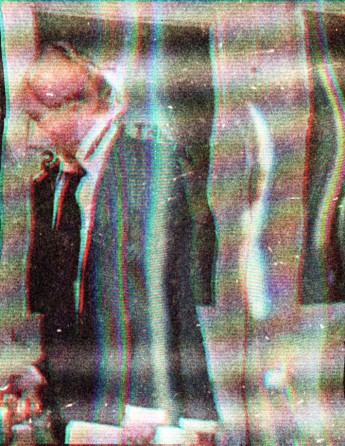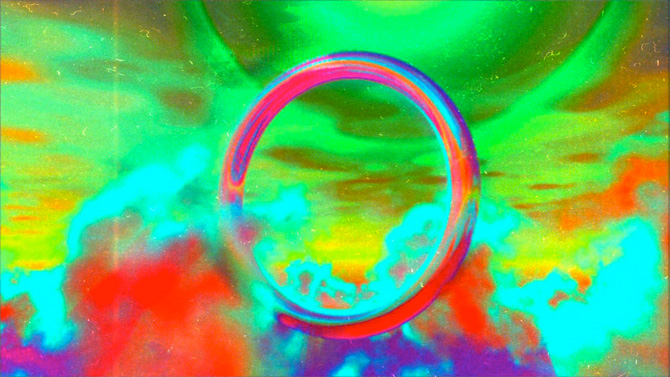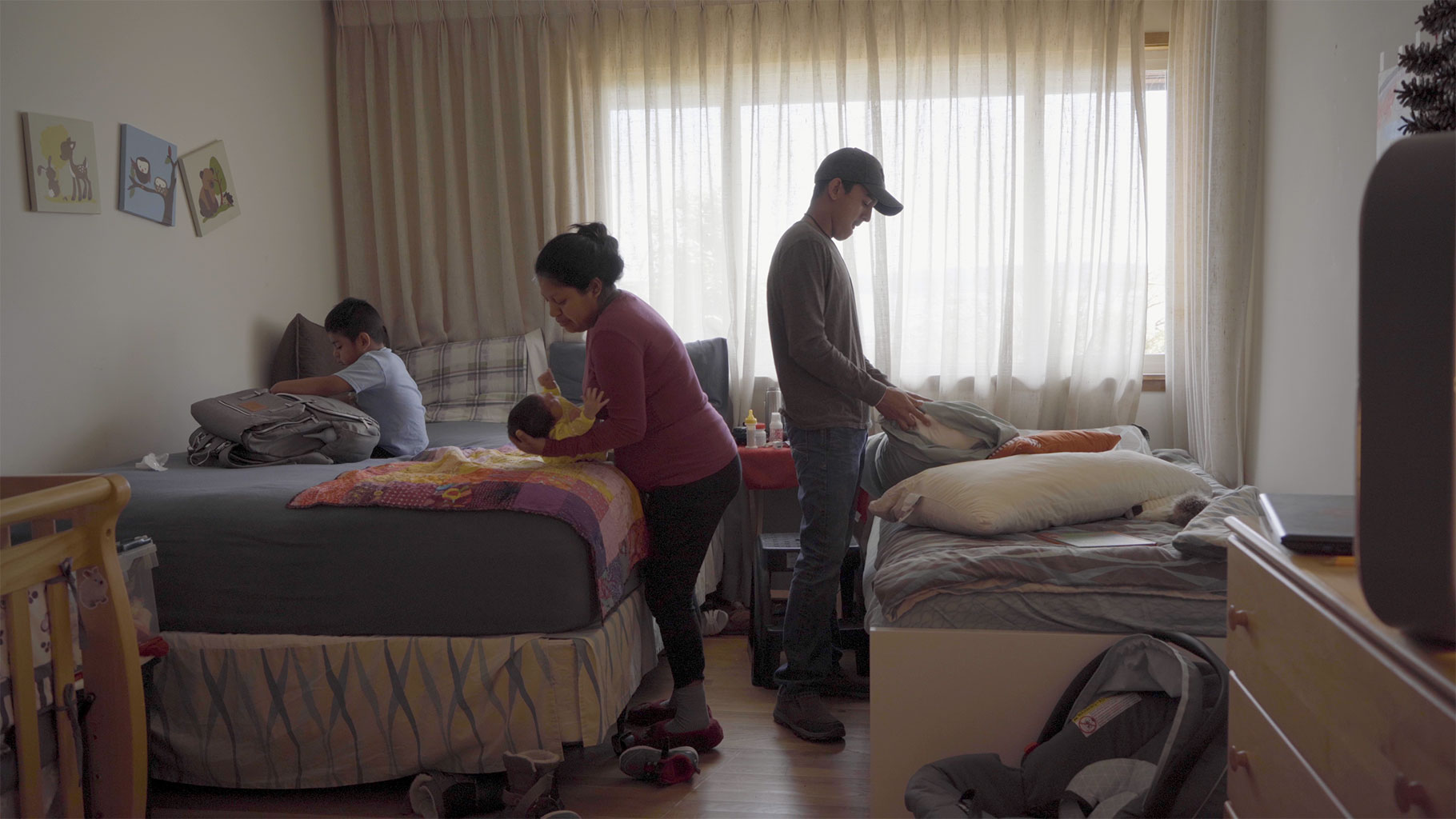The Fragmented Body
Feedback Eruption


Yoshi Sodeoka often dehumanizes the body in his videos, as in Feedback Eruption, where disembodied arms form geometric, fractal-like shapes. This machinistic fragmentation of the human body removes any semblance of identity from the form, making human presence insignificant. This allows for further interpretation of the commentary on exclusion and selection that is present in Sodeoka’s audio-visual work. In the same way that the dichotomy of musical sound and noise is challenged, the human-centric perception of visual narrative is destroyed in Sodeoka’s psychedelic turmoil. The disorienting, fragmented form of what was initially a familiar body becomes an extension of the inhuman, technological noise. By distorting the body–the origin of perception and orientation–Sodeoka breaks the iconographic status of the human self.
Salem Triptych

In Salem Triptych, Sodeoka explores a traditional form of iconography through a spectrum of visual distortion and geometric detail. Emphasizing the influence of grainy noise aesthetics in the image series, Sodeoka uses subtle detail to bring attention to movement. The multiple sets in the series each consist of three aligned frames. Sodeoka uses alternately white and black lines to create faintly visible architectural spaces and intersections across the frames, in a way that unites the images even through their thick black frames. The complex haze of the images’ distortion directs attention to those aspects of the photographs that are just barely recognizable. There are hints of a monuments or concrete protrusions, white-outs and gleaming color bleeds suggest windows, and long scrapes across the frames suggest movement. Yet, a quiet sense of unease is evoked among these structural elements by the transparent blurs of human portraits.
Distortion IV (L); Distortion II (R)


Aligning this inclusion of the human body in his distorted imagery, Sodeoka engages the viewer with the absurdity of human presence. The apparent transience of the body in Salem Triptych is complemented further by the chilling portraits in Distortion. Likewise captured in moments of transition, faces are obscured by visual noise, requiring the viewer to take greater pause over the image to fully reveal the layered shapes in Sodeoka’s chaotic compositions. In Distortion II, the schizophrenic fragments of a woman’s face appear to unveil the many layers of identity; one layer teases with a coy kohl-lined eye peering back at the viewer, the second betrays a gaze of distress, the third reduces the face to a bare skull with a single eye rolled up in its socket, exposed all the while under digital glare. This unsettling image seems to ask of the viewer, what is left of the documentation of greatness, of human historic significance, of personal memory and identity, in the fragility of the technological realm?
Based on this reassignment of representational status, noise, according to Hegarty, can be seen as “an intervention at the level of meaning, one that challenges existing meanings and patterns, leading to questioning (and therefore highlighting the attribution of meaning), and, eventually, if not always, in the recuperation of noise as new system.” Experimentation with the definition and presence of noise allows for the creation of new systems of meaning in the visual environments created with this aesthetic; Sodeoka’s Universe / Calibration already demonstrates such potential for self-containing mythology. By the very nature of the disruptive aesthetics Sodeoka uses, the audience is challenged to reconsider the interpretation and presence of meaning in digital artifacts, as well as the very systems by which their meaning can be attributed.
The absence of explicit narrative in Sodeoka’s videos, largely in favor of an interpretive selection of symbols that are just easily ambient as they are primary actors in a constructed story, is one such example of Sodeoka’s disturbance of systems of interpretation in music videos. Sodeoka’s aesthetic is unique in a visual language that is often pure presence–incapable of being reduced to constructs of narrative. In this way, the role of the viewer is as important to the creation of significance in Sodeoka’s videos as the represented content itself.
My Panda Shall Fly – “Rainfall” Music Video
Yoshi Sodeoka’s most recent music video for “Rainfall”, commissioned by London-based future-soul musician My Panda Shall Fly, reflect Sodeoka’s musically-inspired process through visual representations of the track’s sonic patterns. The pattering synth of My Panda Shall Fly is complemented by Sodeoka’s control of color and the multiplication of creatures depicted in the video.
Sodeoka plays with fantastical, magical elements, and creates subtle illusions of space in the flying hummingbirds, butterflies, and flower petals — but his predilection towards the macabre becomes visible when the cheerful fantasy is overtaken by ravens, in synchronicity with Panda’s use of fragmented hypnotic vocals. Apocalyptic themes make their subtle entry with animals and humans running against the explosions of garbage, and the absurdity of consumer objects explodes into rainbows of daisies. Frogs, fish, and insects begin to fall from the sky in showers of blood, referencing Biblical plagues. Sodeoka’s manipulation of spatial perception becomes clearer as the perspective shifts from the water’s horizon to look at the sky. Meteorites hurl past the screen, and earth implodes into a plasmatic, embryonic blue matrix.
Mythical Journey in Digital Psychedelia




The void of narrative characteristic of Yoshi Sodeoka’s work forces the audience to create their own, or at the very least, to engage in questioning rather than just observing or witnessing the video. Sodeoka creates work that places less emphasis on being entertaining–despite its psychedelic appearance–than it does on being a stimulant for reflection. It is in this way that Sodeoka’s work fulfills its own fate, acting as a psychedelic in stimuli, and not just in aesthetic. The fixation on symbolism and allusions to the mystical experience in Sodeoka’s work return to the artist’s experimentation with the viewer’s perceptual experience. Sodeoka cites Joseph Campbell’s monomyth, or Hero’s Journey, as a significant inspiration behind his Sibyl video series. At the core of the Hero’s Journey is the schism of self at the threshold of the known and the unknown, the transformation through reclaimed awareness, the passage through death, and the return into a self that remains conscious of both realms of experience.
Sodeoka’s videos do not explore this mythology with the excitement typically assigned to narrative structures, but they do contain the implication of self-awareness on the part of the viewer–requiring a thoughtful participation in interpreting experimental imagery that is sometimes more reserved than overtly symbolic. In collaboration with musician Daron Murphy, Sodeoka explores modes in which his animation can allow the viewer to occupy “the role of the shaman” in a kind of recreation of Campbell’s trajectory of character development. Especially representative of this mythical process are the videos Acheron’s Pyramid and Radioactive Mountain, which both rely on communication that is formed without the use of narrative progression.
Radioactive Mountain is potent in its minimalism; the restraint of movement and apparent absence of event in the video concentrates the viewer’s attention on the subtle changes. Here again, the influence of noise music and the subtle gesture of sound that is inherent to it, is evident in Sodeoka’s work. Mirroring the paradoxical heightening of awareness that is created through an immersion in noise, Sodeoka represents this same process in Radioactive Mountain with slow, sustained frames that gradually overlap each other. On its own, Radioactive Mountain is more an exercise in pretty image transition than anything else, however in the Sibyl series context it represents elements of Sodeoka’s interest in Campbell’s monomyth, with the focus on breaking the viewer’s perception of space and orientation, and the visible displacement of the viewer by lifting them from the depicted canyons into the stratosphere.
Acheron’s Pyramid is then Sodeoka’s more blatant experiment with expressing visual and sonic mythology. The viewer is first confronted with an abrupt dissociation from the sensible by being presented with inexplicable geometric shapes, which seem to have no context or meaning. Sodeoka sustains these strange objects over several frames, bringing to mind the perceptual surrender referred to by Hegarty that qualifies noise as ambiance. As the self is dissociated from the viewer’s expectation for meaning to be assigned to the floating forms, the distancing parallel planes of Acheron’s Pyramid finally dissolve. The scene is overtaken by a swarm of disembodied heads–transparent and ethereal like the apparition of Psychedelic Death Vomit–which seem to represent the multiplicity of created identities but the inescapable uniformity of the essential human form. The deity constructed out of human ideal arises, the guardian of the threshold that gazes upon the viewer, as Sodeoka’s music begins to rupture and fold into ominous discordance.
Archeron’s Pyramid // Lyre of the Priestess
What is the narrative significance behind “Acheron’s Pyramid//Lyre of the Priestess”, and how did you first become interested in it?
“Acheron’s Pyramid // Lyre of the Priestess” is one of the videos of the whole Sibyl series. Sibyl is a psychedelic short film project that’s inspired by progressive rock. I do this with my friend and music collaborator Daron Murphy.
We both are huge music geeks and love all kinds of music. I had a phase to revisit and listen to a lot of progressive rock a couple of years ago. Then I thought it would be interesting to approach progressive rock from a visual artist point of view. Themes that progressive rock bands deal with are visually inspiring to begin with. Pink Floyd and King Crimson are good examples.
Then we needed our own story and concept for the project. So we started brainstorming some ideas together and started writing things. We were looking for some themes that relates to mythology which was also our interest at the time. We settled with Sibyl at the end because Daron actually visited the real physical site of the cave of the Cumaean Sibyl near Naples back in 2010. He told me about the story. I was totally intrigued by it and saw a lot of potentials for this video project. Then we started writing ideas together and started to build the whole structure around with that concept. The project is still ongoing, by the way.
www.sodeoka.com
Ω







[…] ARTICLE: YOSHI SODEOKA VIDEO ARTISTS INTERVIEW: PSYCHEDELIC APOCALYPSE IN THE DIGITAL REALM // for REDEFINE […]
[…] Yoshi Sodeoka Video Artist Interview: Psychedelic Apocalypse in the Digital Realm […]